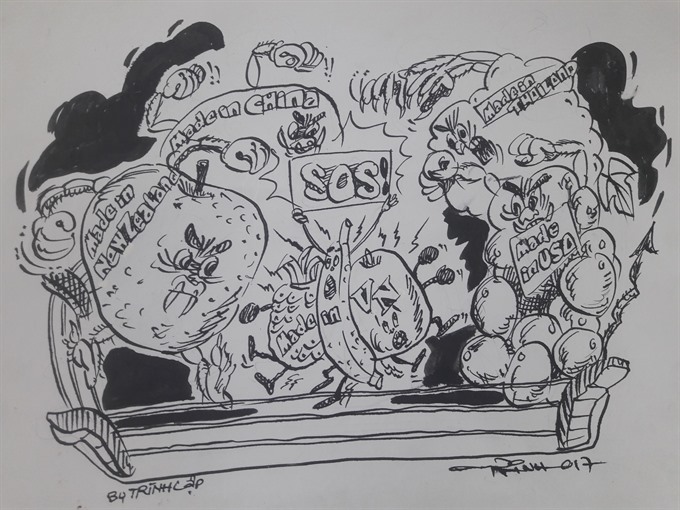 Talk Around Town
Talk Around Town

What to eat and drink has become a major topic of conversations these days, and very often, this turns out to be controversial. A trend has emerged over the last few years of people in major cities preferring to buy imported fruit.
 |
by Hoàng Linh
What to eat and drink has become a major topic of conversations these days, and very often, this turns out to be controversial.
People talk about ways in which fruits are ripened, artificially coloured or coated, how excessive use of chemicals in production make the fruits toxic, how fruits from a particular country are dangerous because they never rot for a long time, and so on.
All said and done, citing reasons varying from food hygiene to wider choice, a trend has emerged over the last few years of people in major cities preferring to buy imported fruit.
“Imported fruit is generally bigger, and have more beautiful colours. The taste is better and more intense. I buy it as gifts for my boss, those who are sick and to share with friends,” said Nguyễn Thu Hương, a housewife.
Hương’s right. The Fuji apple, Thomcord grape from the US and strawberry from Australia are bigger in size and taste better than local varieties. And then there are some fruits that do not grow in Việt Nam, making imported ones an even better choice as presents.
“I used to buy Vietnamese fruit a lot to present to people. However, I prefer imported ones now. We have the tradition of giving fruits and an envelope of money when people are sick, but these days, not many people like to receive money. So I buy imported fruit so that the offering looks more valuable and I myself feel better about it,” Hương said.
Imported fruit is expensive. A kilo of New Zealand apple can cost up to five times than Vietnamese apples. But many people do not hesitate to choose the expensive option. In the homes of many wealthy families, domestic fruit has been replaced with imported ones.
“The first reason is better taste. Another is that they do not eat much, so they want to use the best products,” said Nguyễn Thùy Linh, a saleswoman at an imported fruit store on Bà Triệu Street in Ha Noi.
“The imported fruit is stamped, making buyers feel more secure about its origin. Nowadays, buyers worry a lot about food origin and hygiene, GMO food, pesticides and other things. Those who can afford it buy imported fruit for such reasons,” Linh said.
However, in several cases, it has been found that fake labels were used on fruit supposedly imported from the US, Japan and other countries. So it has become even more difficult to be sure of the fruit’s origin.
Despite this, the volume of imported fruit sold in the market is still high, which means Vietnamese fruit farmers are suffering.
In February, banana farmers in several provinces were hit as prices plummeted from VNĐ14,000-17,000 per kilo to VNĐ1,000-3,000. Unable to sell, the farmers fed their cattle with the fruit.
Several campaigns have been launched this year to encourage people to buy Vietnamese fruit and support local farmers. While these campaigns do succeed partially in getting people to buy Vietnamese fruit, the habit is not sustained.
Early April this year, hearing that farmers growing watermelons in Quang Ngai could go bankrupt because they were not able to sell their produce, HCM City residents launched a campaign to help them. A wide cross section of the people responded, including office workers, students and housewives.
This has happened previously with banana in Dong Nai, lychee in Bac Giang and dried onions in Soc Trang.
But experts say that such campaigns can only be stop-gap measures to reduce farmers’ losses. It cannot happen whenever the price of farm produce drops.
So what can be done?
It is clear that with a population of over 90 million, there can be a big market for domestic fruit, and our farmers should do well.
Of course, farmers and processing enterprises should improve product quality, but they need the incentive of decent prices and guaranteed sales, which is where we consumers come in.
Are we ready to support our farmers in the long run? VNS




